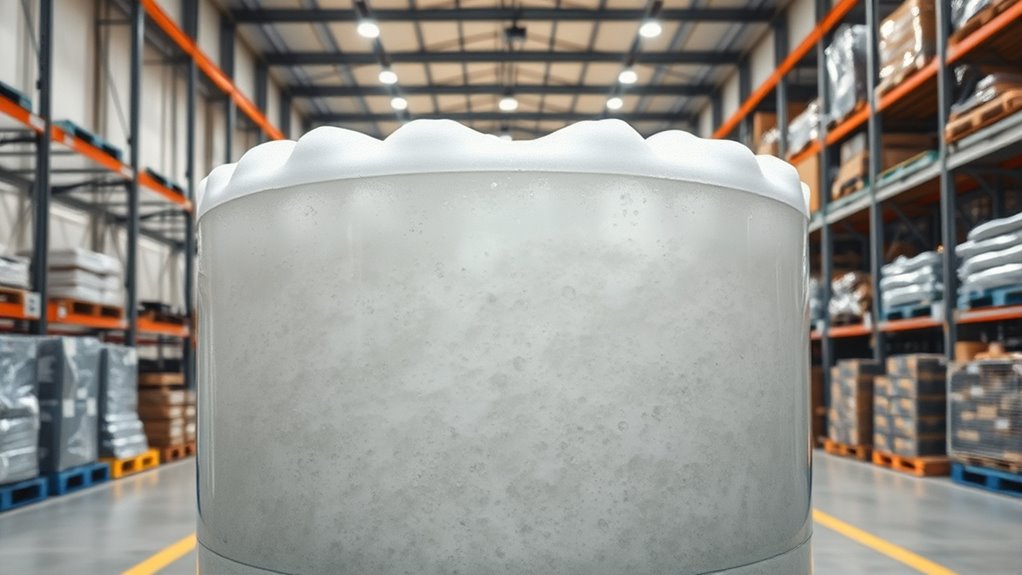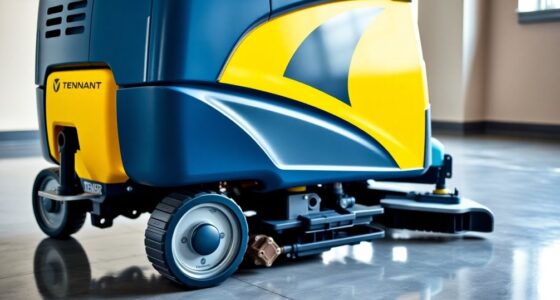If you notice foam in your recovery tank, using a suitable defoamer can quickly break it down and prevent overflow or contamination. Verify the defoamer you choose is compatible with your chemicals and system to avoid reactions that could worsen the problem. Regularly inspect and maintain your foam control systems, and monitor chemical compatibility to prevent future buildup. Keep learning about proper foam management methods to keep your warehouse safe and efficient.
Key Takeaways
- Use appropriate, compatible defoamers designed for your chemicals to effectively break down persistent foam.
- Regularly inspect recovery tanks for foam buildup and adjust foam suppression systems as needed.
- Ensure proper chemical compatibility to prevent reactions that generate excess foam in the tanks.
- Maintain and calibrate foam control equipment routinely to optimize foam suppression performance.
- Train staff on correct chemical handling and foam prevention practices to minimize foam-related issues.

If you notice foam accumulating in the recovery tanks along warehouse aisles, it’s a sign that something needs your immediate attention. Excess foam isn’t just an annoyance; it can signal underlying issues with your cleaning or processing systems. One common cause is inadequate foam suppression, which occurs when the foam generated isn’t properly controlled or broken down. To address this, understanding chemical compatibility becomes essential. Not all chemicals interact the same way, and using incompatible products can lead to excessive foam formation, making it harder to maintain a safe and efficient environment.
Foam buildup signals potential chemical incompatibility and system inefficiencies needing prompt attention.
When dealing with foam in recovery tanks, your first step is to identify the root cause. Sometimes, the chemicals used aren’t compatible with the foam suppression agents or equipment in place. Chemical compatibility is critical because incompatible substances can cause foam to persist longer than it should or even create new foam issues. Make sure you review your chemical labels and Material Safety Data Sheets (MSDS) to confirm which products can be safely mixed and which require additional foam suppression measures. Using the right combination helps prevent foam from spiraling out of control and reduces the risk of overflow or contamination.
Foam suppression methods are designed to minimize foam formation and facilitate easier cleanup. Installing foam control agents or defoamers tailored to your specific chemicals and process is a practical step. These products work by breaking down the foam bubbles, allowing your recovery tanks to operate smoothly. When selecting a defoamer, ensure it’s compatible with your chemicals; otherwise, it might cause adverse reactions or reduce the effectiveness of your cleaning agents. Properly calibrated foam suppression systems not only improve safety by preventing spills but also enhance overall efficiency by reducing downtime for manual foam removal. Regular maintenance and monitoring are key to preventing foam issues. Keep an eye on your tanks and check for signs of foam buildup frequently. If you notice foam persists despite suppression efforts, it might be time to reassess your chemical choices or upgrade your foam control systems. Training your staff on proper chemical handling and understanding the importance of chemical compatibility can go a long way in avoiding future foam problems. Ultimately, a proactive approach that integrates effective foam suppression techniques and careful chemical management helps maintain a safe, clean, and efficient warehouse environment. Additionally, utilizing appropriate foam control products recommended for your specific chemicals can significantly reduce the likelihood of foam-related issues.
Frequently Asked Questions
Can Foam Damage Warehouse Equipment or Inventory?
Yes, foam can damage warehouse equipment or inventory if not managed properly. It can cause slips and falls, jeopardizing warehouse safety, and may lead to equipment malfunctions or corrosion. To prevent this, you should prioritize foam cleanup quickly and effectively. Using the right defoamer helps control foam, reduces hazards, and protects your inventory, ensuring a safer, more efficient warehouse environment.
How Often Should Foam Levels Be Checked?
You should check foam levels regularly to guarantee safe operation. During foam monitoring, inspecting the recovery tank at least every shift helps catch any buildup early. Increased foam signals may indicate issues needing immediate attention. Consistent inspection frequency prevents equipment damage and maintains warehouse safety. Make it a habit to monitor foam levels proactively, especially during high use periods, so you stay ahead of potential problems before they escalate.
Are There Safety Concerns With Foam Chemicals?
You should be aware that foam chemicals pose safety concerns related to chemical safety and health risks. Always handle defoamers with proper protective gear, like gloves and goggles, to prevent skin and eye irritation. Make certain good ventilation to avoid inhaling fumes. Follow manufacturer instructions carefully, and store chemicals securely. Staying informed about safety procedures helps minimize health risks and keeps your workplace safe when managing foam in recovery tanks.
Can Foam Indicate Other Underlying System Issues?
Yes, foam can signal underlying system issues. When you notice excessive foam during foam monitoring, it’s a sign to run system diagnostics to identify problems like incorrect chemical levels or equipment malfunction. Foam buildup might indicate leaks, improper chemical mixing, or inadequate maintenance. Addressing these issues early guarantees your system runs smoothly, preventing bigger failures and maintaining safe, efficient warehouse operations.
What Maintenance Prevents Excessive Foam Formation?
To prevent excessive foam formation, regularly inspect and clean your recovery tanks, ensuring proper chemical compatibility to avoid reactions that cause foaming. Use appropriate defoamers as needed, and monitor chemical levels to prevent imbalance. Maintaining equipment properly also minimizes environmental impact by reducing spill risks. Consistent maintenance helps keep foam under control, preventing system issues and ensuring safe, efficient warehouse operations.
Conclusion
Now that you know how to tackle foam in your recovery tank, aren’t you ready to keep your warehouse aisles clean and safe? Using the right defoamer and maintaining proper procedures can prevent messy spills and equipment issues. Imagine walking through a clear, foam-free aisle every day—doesn’t that sound like a smoother, more efficient workspace? Stay proactive, and your warehouse will stay running smoothly without foam disruptions.









